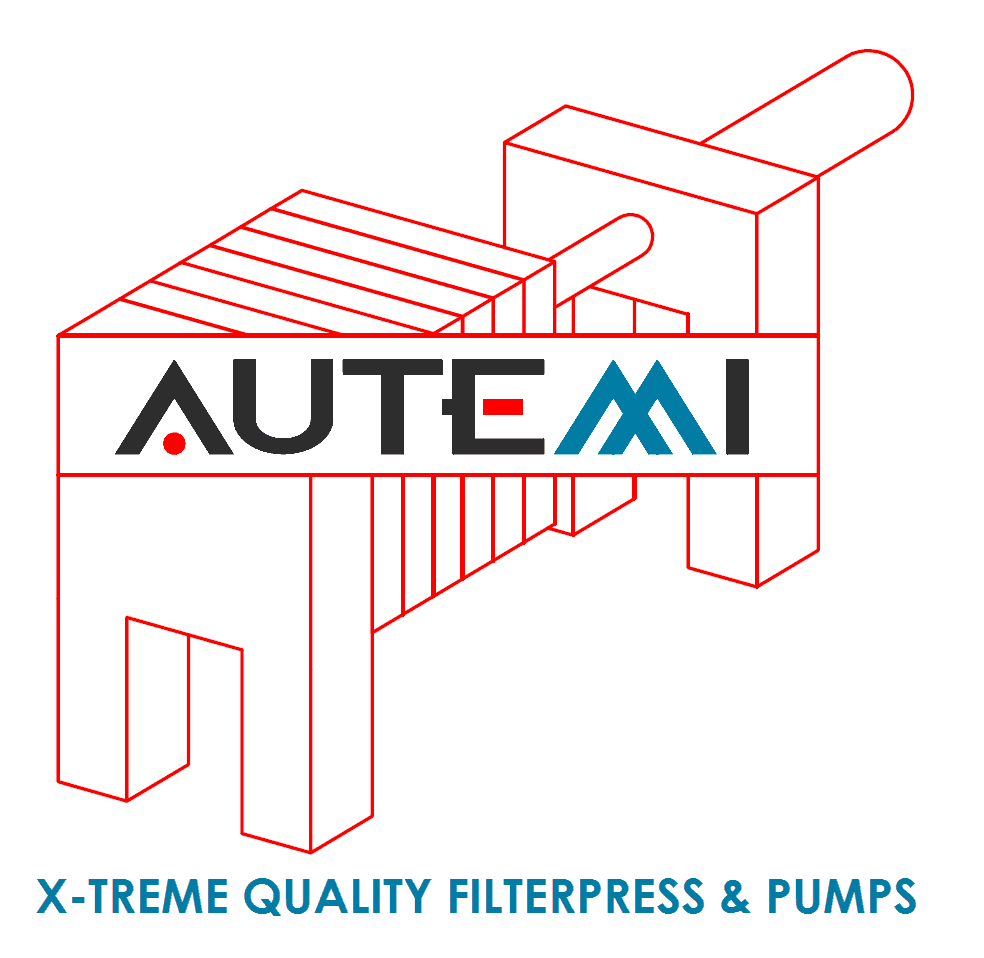
One machine – Many applications

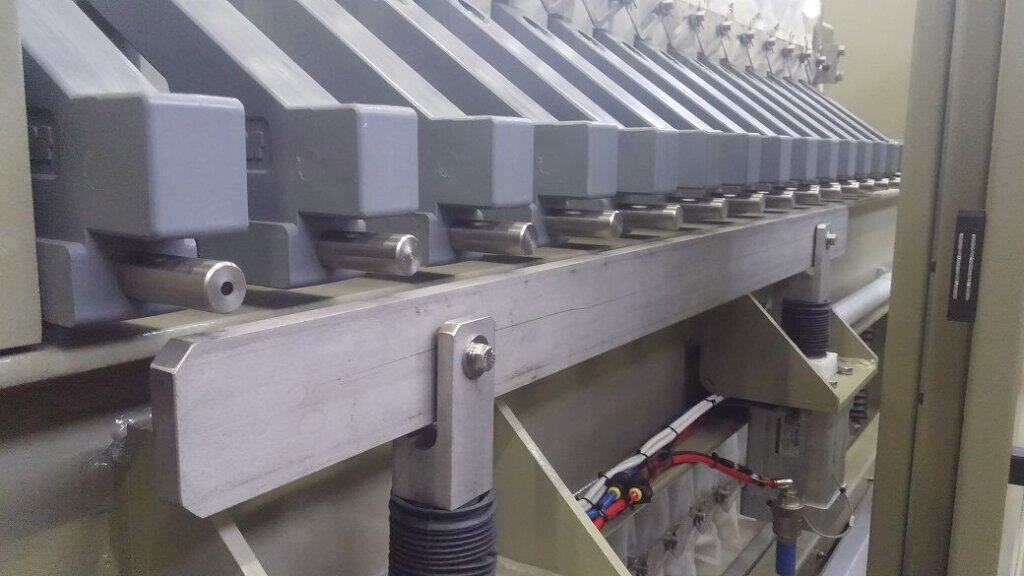
THE BEST SOLUTION FOR SOLID-LIQUID SEPARATION
The plate filter press is the dewatering system that provides maximum efficiency in terms of solid-liquid separation combined with low installed power, low maintenance and operating costs.
SIMPLE DOES NOT MEAN TRIVIAL
Autemi’s filter presses are used in a variety of industrial sectors, such as the wastewater, aggregates, chemical, galvanic, tannery and many other applications.
Although the principle behind the operation of the filter press is always the same, what changes are the features in terms of options and functionality, installed components, materials, safety devices, automation and customisation.
In fact, it is necessary to know the field of application, the characteristics of the fluid to be treated, the customer’s needs in terms of the degree of automation expected, expected performance, and a careful analysis of all the factors that contribute to the definition of the machine.
Always be careful of those who offer you a standard solution at low cost, because you are putting the efficiency of your plant at risk!
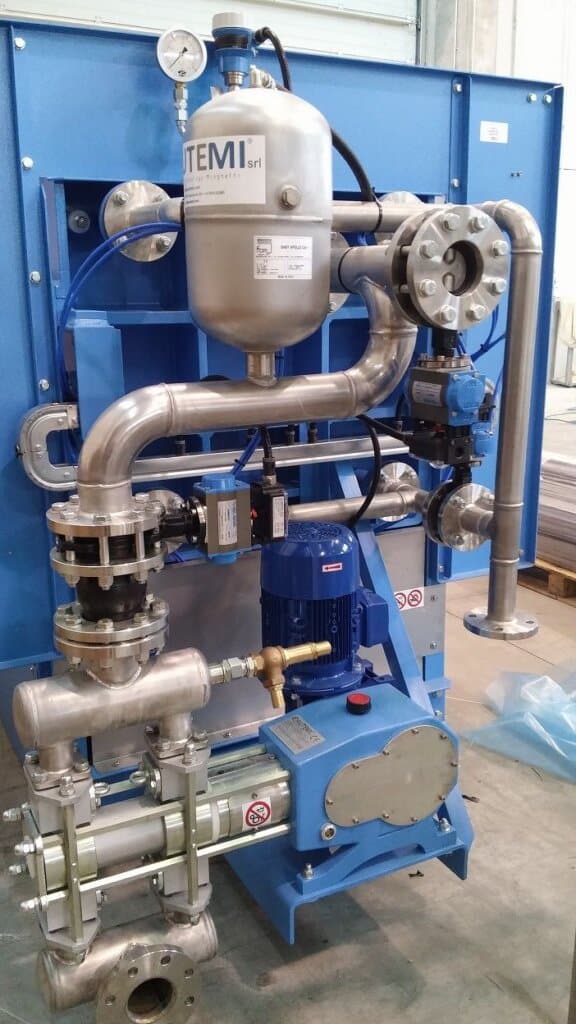
A COMPLETE RANGE AT YOUR SERVICE
Autemi provides its customers with a range of versions, options and combinations that is really unique on the market!
From the components installed, to the material combinations, through the degrees of automation and the countless optional extras available, we can meet all challenges.
If you are already an experienced user, you will be able to access the page with all the models and versions in the range where the various optional extras are analysed, what they are used for and why you should know about them.
If, on the other hand, you are not an experienced user and would like to learn more about the basics before requesting an offer tailored to your specific case, I suggest you continue reading this page.
Or, even if you are an experienced user, you can continue reading to strengthen your knowledge and discover all the details that other manufacturers do not tell you.
We will review all the main features of filter presses, the most common mistakes you should avoid making, and what you need to know to maximise your system investment.
FILTER PRESS IS AN INVESTMENT, NOT AN EXPENSE!
The filter press is the best solution for sludge dewatering
Exactly as in all investments, the parameter you have to consider most is precisely the return you will get during use. You should not look at price alone as investments should be measured in the medium to long term.
So if your focus is only on the low price, you are making an initial mistake that could actually cost you more.
What you need to consider is how your system works and the conditions under which you use your machine. Do not fall into the trap of those who offer you standard solutions just to show you the lowest price.
Let me give you an example: many times I personally went to my customers’ sites to evaluate the replacement of their old plate filter press with a new one, and what I saw was disarming. It is clear that when you have to compete on price with a machine reduced to the bone, the battle becomes difficult, but what I would like to make clear is: “where is the advantage?”.
The filter press is the best solution for sludge dewatering
Returning again to our example, a filter press that is coupled to a pump that can at most reach 5/6 bar, do you think it can perform as well as a filter press that is designed to withstand a pressure of 16 bar? I think this question is actually rhetorical, but the point is: was the saving that the potential customer had in buying a low-pressure machine really a saving? How much more money was spent over the life of the machine to dispose of a sludge that could have had a much higher dry solids content of several percentage points? How much is an extra percentage point of dry solid worth with your flow rate of sludge that you have to dispose of periodically?
I ask you this because I could tell you the story of a customer of mine who only by changing the feed pump had a return on investment in 3 months!
If you want to know the numbers of your plant and make an economic assessment to evaluate the return on your investment, I invite you to contact us to have more informations to evaluate your investment.
FILTRATION IS NOT AN EXACT SCIENCE!
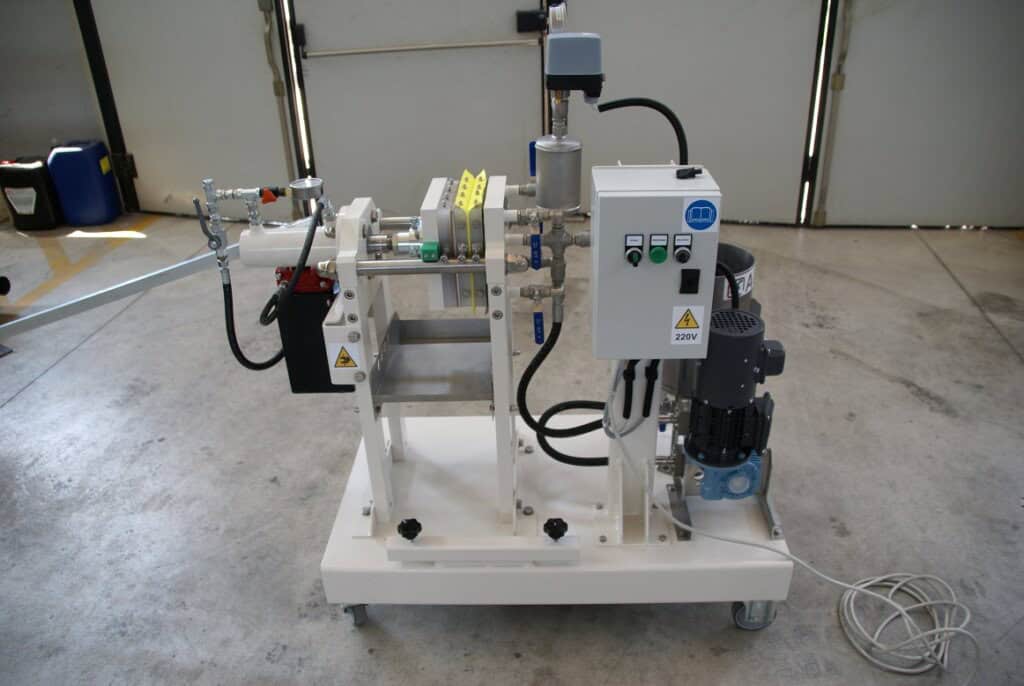
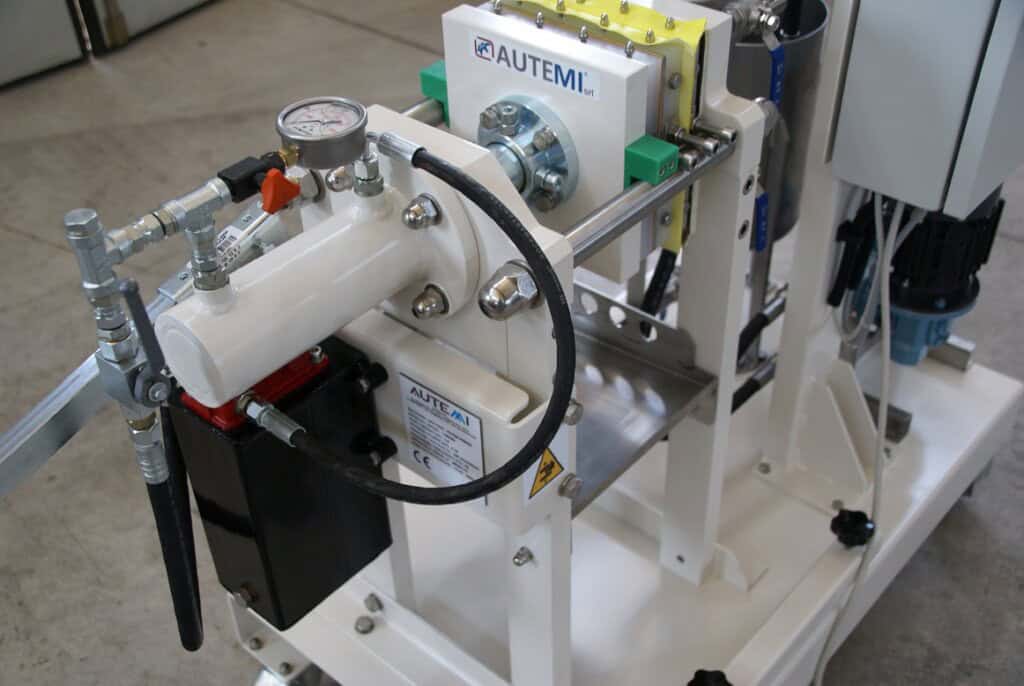
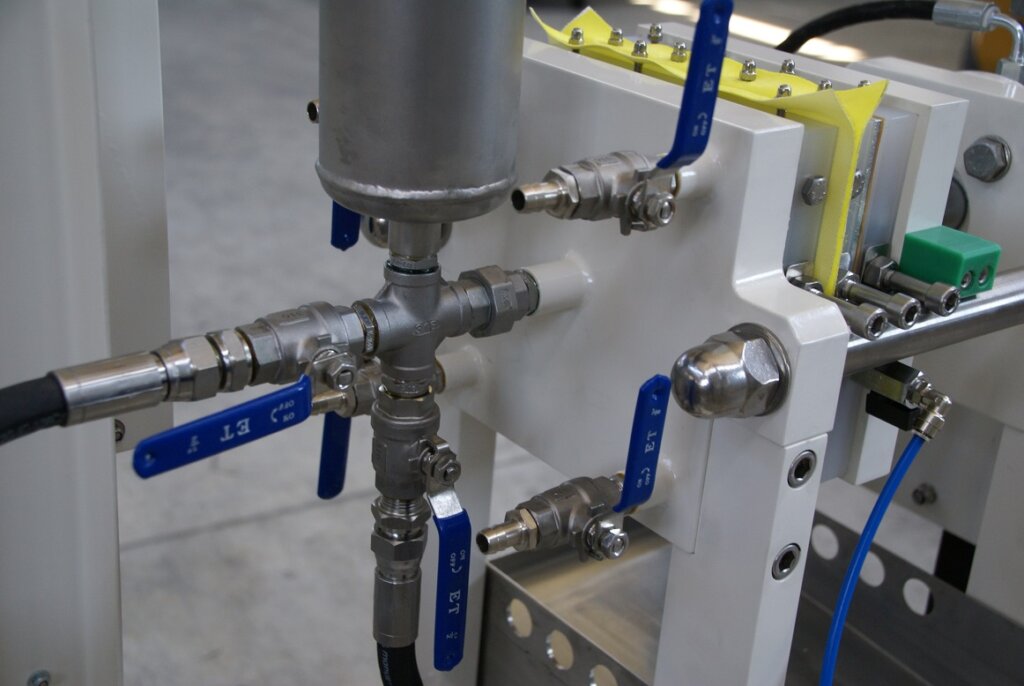
Returning to the high-pressure/low-pressure discussion, the question is: how do I know at what pressure the sludge is filtered?
The answer is very simple: by doing an experimental test!
I think you will agree with me that you don’t need to be a technician to realise that a machine that withstands a pressure of 6 bar is certainly less expensive than a machine that withstands up to 15 bar! Certainly the push is more than double in the last case. Of course there is a price difference.
But then why should I do an experimental test?
To understand how the sludge is filtered, which variables are important during the filtering phase and how I can design the machine around this test.
The test is carried out on a pilot filter press, which is nothing more than a real miniature filter press used to test how the industrial machine will behave: it is not therefore a test that has nothing to do with real operating conditions, but simulates precisely what will happen in reality.
Once we have done the lab test, we understand what pressure is sufficient to go to, what type of cloth we need to use, how long the filtration phase lasts, and how we can maximise the sizing of the filter press.
We also understand if we need additional options, which certainly cost more but can bring me a considerable advantage!
For example, I may find that with a small additional optional extra I can increase the dry matter content by 1 or 2 percentage points and significantly help the separation of the residual cake.
This can greatly change the sizing of the machine in the customer’s favour!
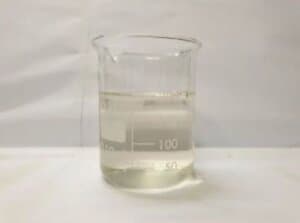
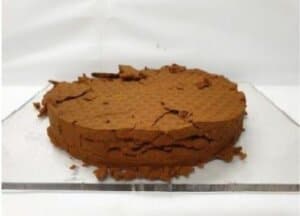
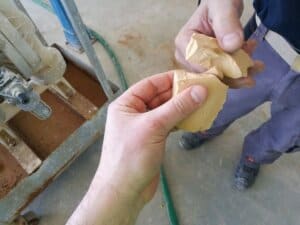
A FILTRATION TEST CAN SAVE YOU A LOT OF MONEY!
If you still do not believe that a laboratory test carried out on your sludge or filter liquid can have a very important impact on the final dimensioning of your machine, I want to bring you a specific example so that you can understand the influence of the parameters that can be verified by the test.
Below are 2 different laboratory tests on two different liquids:
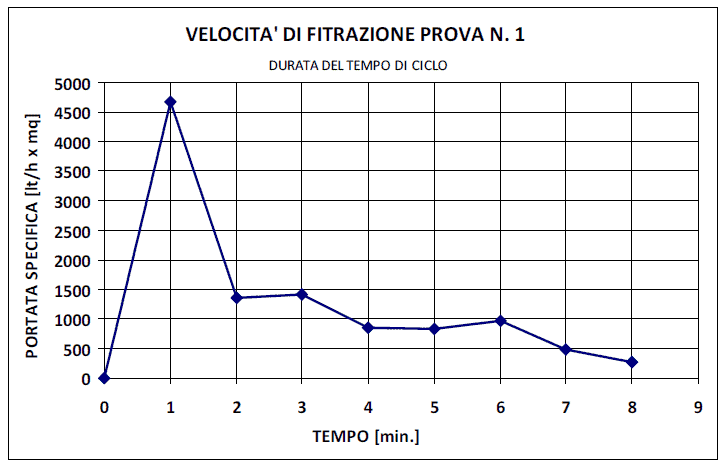
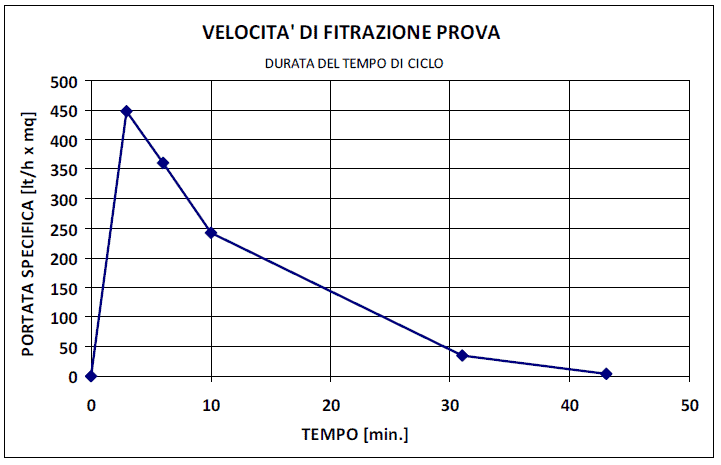
Performing a filtration test is the best way to allow you to size the correct machine for your application.
One does not need to be a technician or an expert to read such a graph. You can see immediately that it took about 8 minutes to filter the first product, and almost 45 minutes to filter the second product.
Just think that there are some muds that filter in 3 or 4 hours because they are particularly difficult to process.
Obviously this means that there can be a big disproportion in results between the various products, so you can get completely different results from one fluid to another.
“HOW LONG DOES A FILTRATE LAST?”: A WRONG QUESTION!
Proprio per il motivo che la filtrazione dipende dal tipo di fluido e di fango che si va a trattare, la domanda che mi sento fare moltissime vole “Ma quanto ci vuole a filtrare questa quantità di fango?” è una domanda sbagliata.
Diciamo che manca una parte. La domanda corretta sarebbe: “Quanto dura un ciclo di filtrazione con questo tipo di fango?”.
Ha tutto un altro suono, non credi?
Tornando quindi all’esempio precedente, per trattare un certa quantità di fluido, in un caso impieghiamo circa 45 minuti, mentre nell’altro caso impieghiamo meno di 10 minuti. Il che tradotto in altri termini significa che a parità di quantità di fluido da trattare, in un caso la filtropressa necessiterà di un certo volume, mentre con l’altro fluido la filtropressa avrà un volume quasi 5 volte superiore.
Ecco perché è meglio scoprire questi dati subito: per massimizzare il valore del tuo investimento. diversamente potrei scoprire ad acquisto effettuato, di avere scelto una macchina troppo grande o troppo piccola quando ormai è tardi.
SO IN MY CASE?
Exactly for the reason that filtration depends on the type of fluid and sludge being processed, the question I hear asked many times “But how long does it take to filter this amount of sludge?” is a wrong question.
Let’s say there is a part missing. The correct question would be “How long does a filtration cycle take with this type of sludge?”.
It has a whole different sound, don’t you think?
So going back to the previous example, to process a certain amount of fluid, in one case it takes about 45 minutes, while in the other case it takes less than 10 minutes. Which translated into other terms means that for the same amount of fluid to be treated, in one case the filter press will need a certain volume, while with the other fluid the filter press will have almost 5 times the volume.
That is why it is better to find out this data now: to maximise the value of your investment. otherwise you might find out after your purchase that you have chosen a machine that is too big or too small when it is too late.
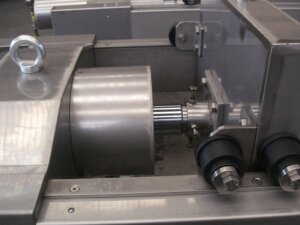
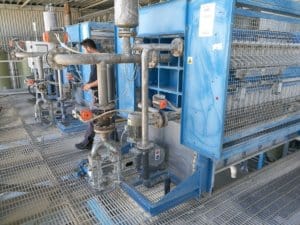
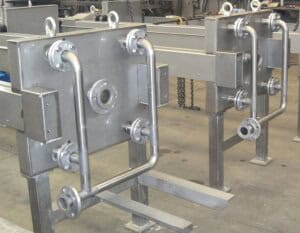
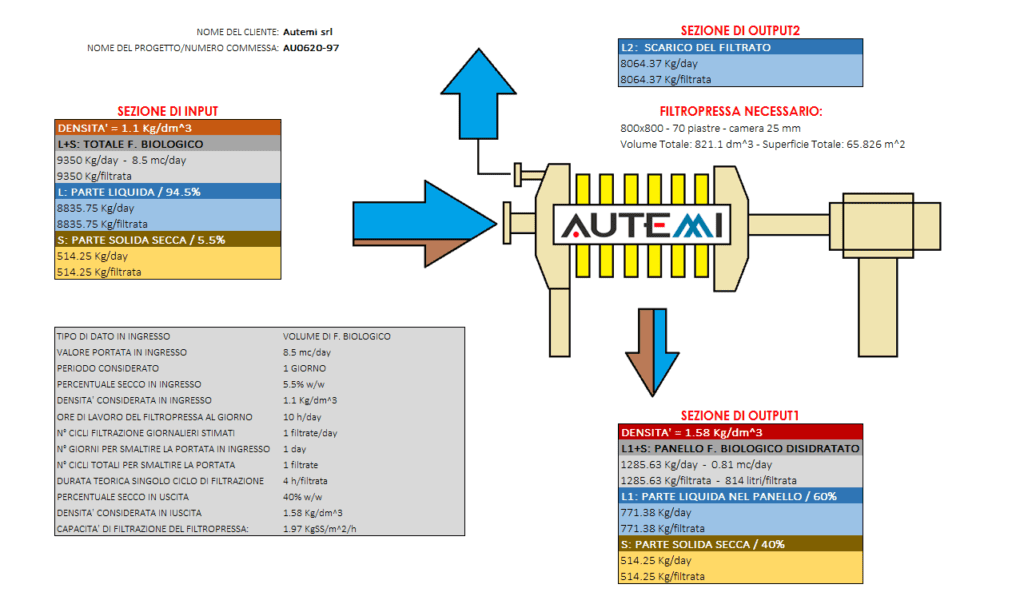
Having all the correct data, laboratory tests showing the duration of the filtration cycle, the dryness that can be obtained, you can proceed to the sizing of the machine and the economic evaluation.
In this way you can calculate the return on your investment more accurately.
WHAT IF THE LAB TESTS CANNOT BE PERFORMED?
In all other cases we rely on similar case histories and experience in the field, making various assumptions about fluid behaviour.
IT’S CALLED A FILTER PRESS,
BUT IT DOESN’T ACTUALLY PRESS!
“What?” – I imagine you are thinking this. Then why on earth is it called that?
Actually, even if you didn’t know it before, the filter press does not press the sludge.
It is the pump that does all the dirty work!
Exactly: the filter press keeps the plates pressed down while the pump sends the liquid (or sludge) to be filtered into the filter chambers.
That’s right, many people think that the pump only serves to initially transfer the sludge inside the filter press, which then mechanically presses what is inside. Nothing could be more wrong: it is the pump (and how it is operated) that is actually responsible for correct filtration.
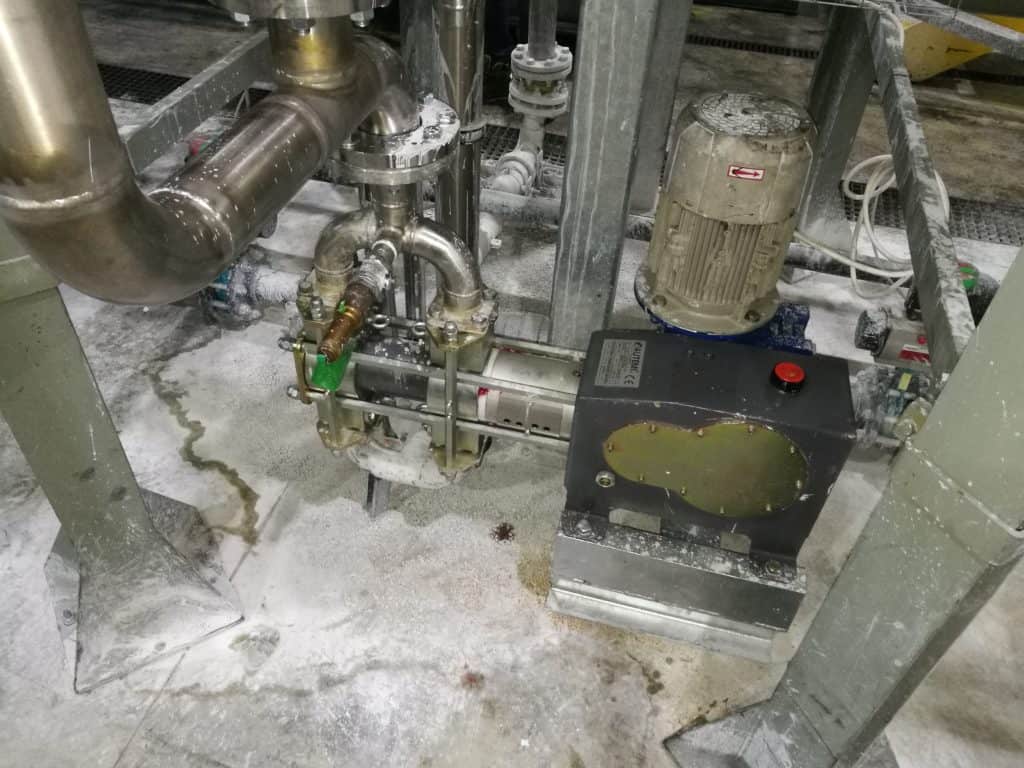
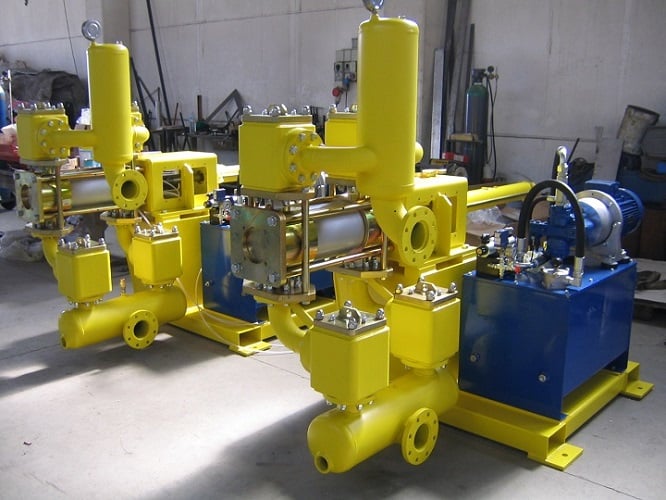
I SPEND ON THE FILTER PRESS BUT SAVE ON THE PUMP!
Now that you have understood how a sludge dewatering system works and you have realised the importance of the feed pump, please do not make the mistake most users or installers make: do not go economical with the feed pump!
Choosing the right feed pump for your filter press is crucial: if the pump is too small, you are not using the full potential of the filter press and you only risk fouling the cloths; if the pump is too large, you are giving a flow rate that exceeds the filter’s demand and you only risk clogging the cloths.
The pump must be centred with reference to the characteristics of the sludge, the properties of the cloth and above all it must be managed correctly!
Management means how the flow rate is managed during the different stages of filtration and how the final stage of filtration is managed.
If you happen to:
-have a very long filtration (more than 4 or 5 hours) even if you are not performing a polishing operation
-have very frequent pump on/offs
-having prolonged periods of pump inactivity during the final filtration phase
then you are probably mismanaging the pump’s operating logic or have chosen an incorrect pump size (usually too small).
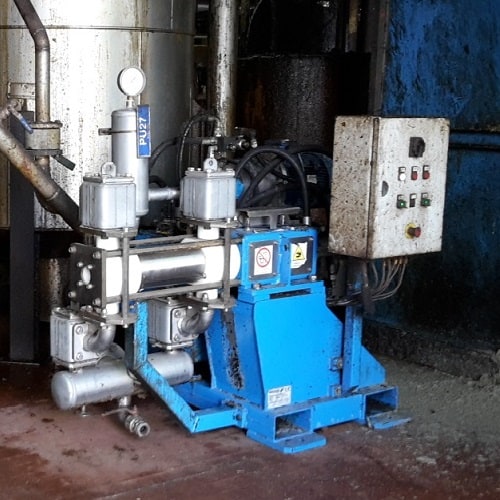
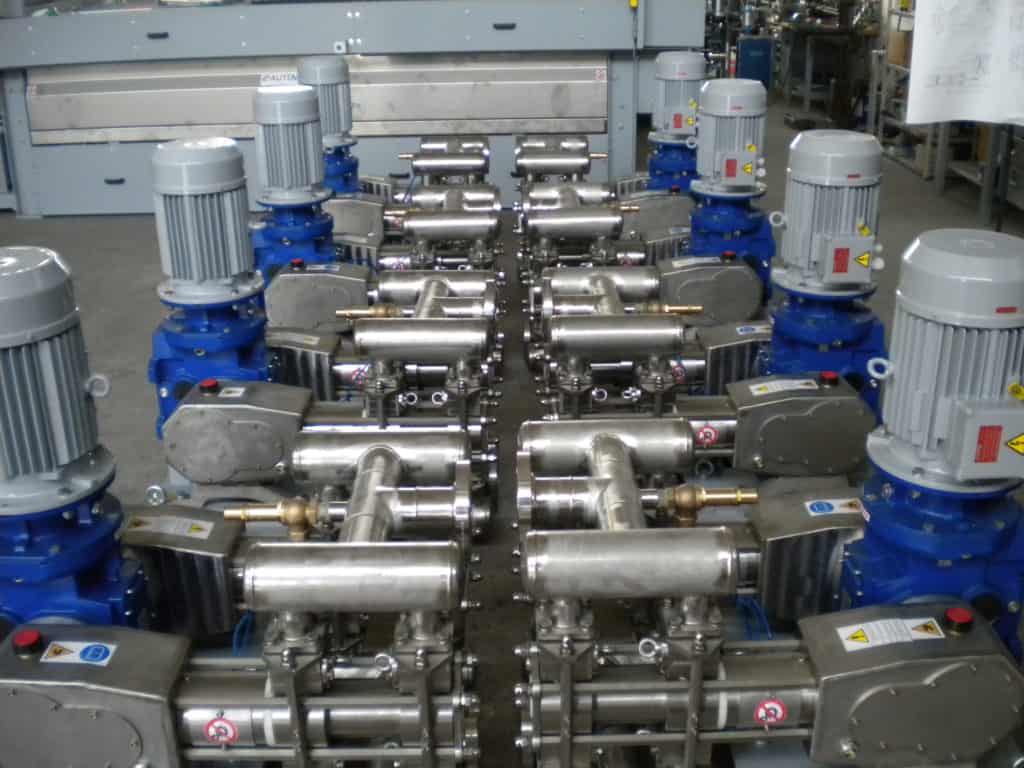
DEMAND A ROBUST MACHINE!
This statement might seem trivial, but if with the advantage of second thought we look at some of the choices that have been made, it seems more than appropriate to reiterate this concept: when you buy a piece of equipment – such as a filter press – that mostly has to operate in heavy-duty environments, price is certainly not the first parameter you have to consider.
It is more appropriate to focus on other factors, such as the strength of the frame, the quality of the materials in contact with the wet parts, the quality of the filter plates, the safety guards, the human-machine interface (HMI), etc.
Always demand material certificates, paint reports.
Also, don’t stop there: always make sure that the pneumatic and electrical wiring is done properly, protected as much as possible from external agents. Also, since the machines must be used by personnel, demand that the control interface is simple and intuitive.
If I have not convinced you enough, take a look at what can happen to your filter press if you do not pay attention to these parameters: welcome to the gallery of horrors!
NOW WHAT STEPS TO FOLLOW?
Now that you have understood what steps to take to correctly size a filter press dewatering system, the services that Autemi s.r.l provides for you are many:
-Customised laboratory analysis aimed at understanding the filtration capacity of your product and sizing a machine for your needs
-Configuration of the machine that best suits the characteristics of your product and your needs in terms of degree of automation, quantity of product to be disposed of, expected results in terms of economic return, etc.
-Preliminary evaluation of all available variants, options and versions best suited to solve your specific problem.
-Possibility of supplying, in addition to the machine, small-scale pilot plants to test the process before moving to industrial scale
